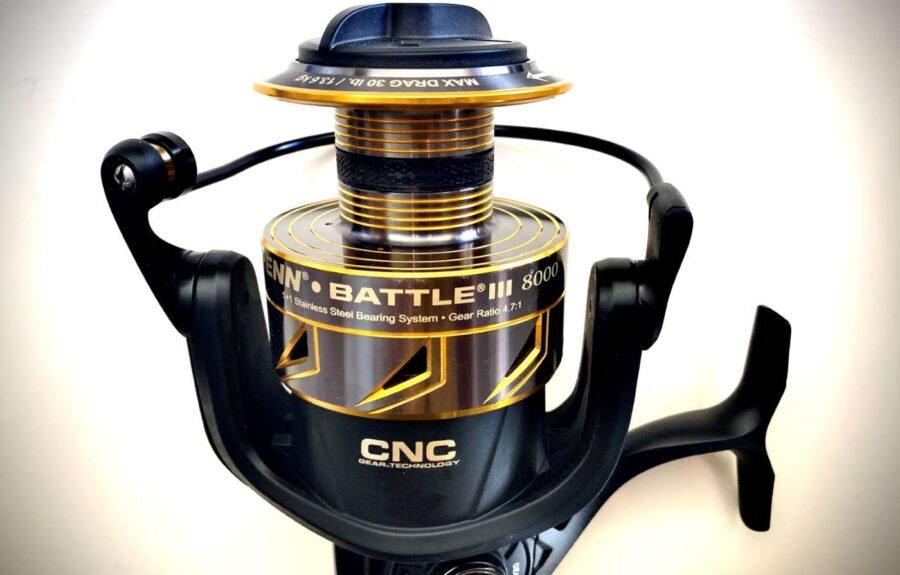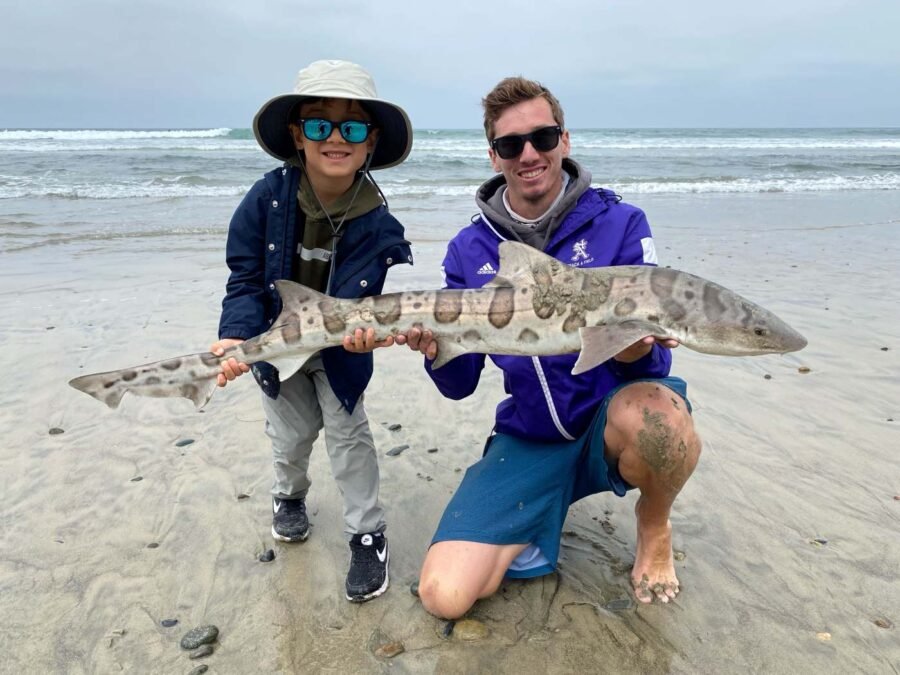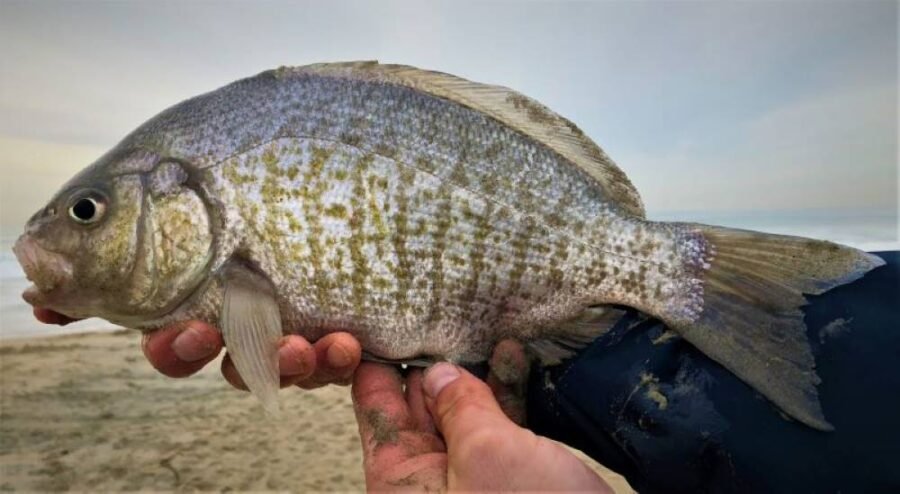Choosing The Best Rod For Surf Fishing: Specs and Length?
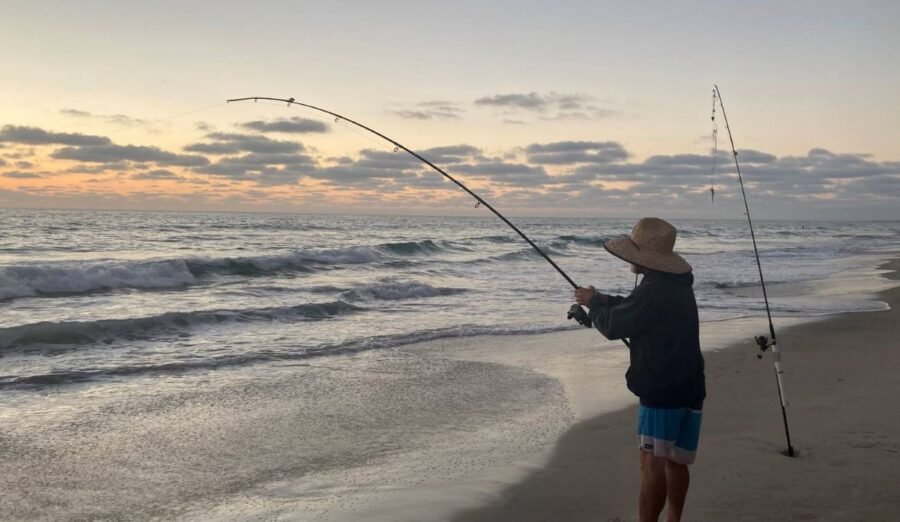
It’s time to talk surf fishing rods! No matter your skill level, it’s important to figure out how long a surf fishing rod should be. Understanding what the best length for a surf fishing rod is and matching up all the other specs on a fishing rod will be your first steps in choosing the best surf fishing rod for you.
Before you go to a tackle shop and get some bad advice on surf fishing gear and tackle, read up and do your research on your target species. Gain an understanding on what surf fishing is and how to go surf fishing, and then follow the sections below to match up your rod and reel to your target species.
Most online resources will tell you you need a really long rod for surf fishing; some say you need a 10-12 foot rod! That’s definitely not the case for most styles of fishing the surf! On the other hand, local tackle shops here in So Cal will tell you that you need a 9-10 foot light to medium light rod and use 6lb test. Don’t listen to those guys! So how long should your surf fishing rod be and what is the best rod length for surf fishing? Let’s find out!
Best Rod Length For Surf Fishing: It Depends!
Any online resource or tackle shop that gives you a general rod length and says, “this is the best rod length for surf fishing” is full of crap and has little knowledge of the sport and all the little nuances that go into selecting the right surf fishing rod.
For instance, in So Cal, I use 3 (sometimes 4) different rods to fish the surf here. And guess what… they’re all different lengths! For a clear picture of the rods that I use for surf fishing, head on over to my article on the best rods for surf fishing. But, long story, short, here’s the length of the rods that I use per surf fishing style.
| Style of Surf Fishing | Best Rod Length |
|---|---|
| Light Tackle (Carolina Rig) | 8’6″ |
| Lures (Jerkbaits) | 8’6″ |
| Lures (Swimbaits) | 9′ |
| Sharks | 13′ |
What to Consider When Choosing A Surf Rod: The Specs
The fact of the matter is that there’s so much more than the length of a rod when it comes to selecting a rod for surf fishing.
You need to think about the material (this essentially determines quality, weight, and longevity). I wrote a really interesting article a few years ago on “Why Fishing Rods Get Expensive: Carbon Modulus, Tonnage, Strain Rate“. It’d be worth checking out if you’re interested in learning about fishing rod material.
Another thing to think about is the rating or line weight of the rod. This is usually displayed in “lbs” and refers to the line you would likely be using with the rod. On top of that, you need to thing about the lure weight (displayed in “oz”, the number of guides, number of pieces you want/need, the power, and the taper (or action). Take a look at the chart below for the specs that I prefer on a surf fishing rod per the style of surf fishing I use it for.
| Style of Fishing | Model # | Line Weight | Lure Weight | # of Guides | # of Pieces | Length | Power | Taper |
|---|---|---|---|---|---|---|---|---|
| C-rig | CE-S-862MA | 8-17lbs | 1/4 – 5/8oz | 7+1 | 2-pcs | 8’6″ | M | MF |
| Swimbaits | SST-S-902HA | 10-30lbs | 1/2-2oz | 8+1 | 2-pcs | 9’0″ | H | MF |
| Jerkbaits | SST-S-862MHA | 10-20lbs | 3/8-1.5oz | 8+1 | 2-pcs | 8’6″ | MH | MF |
| Sharks | MO-S1304 | 20-40 | 4-8oz | 5+1 | 4-pcs | 13’0″ | H | MF |
Breaking Down What the Specs on a Fishing Rod Mean
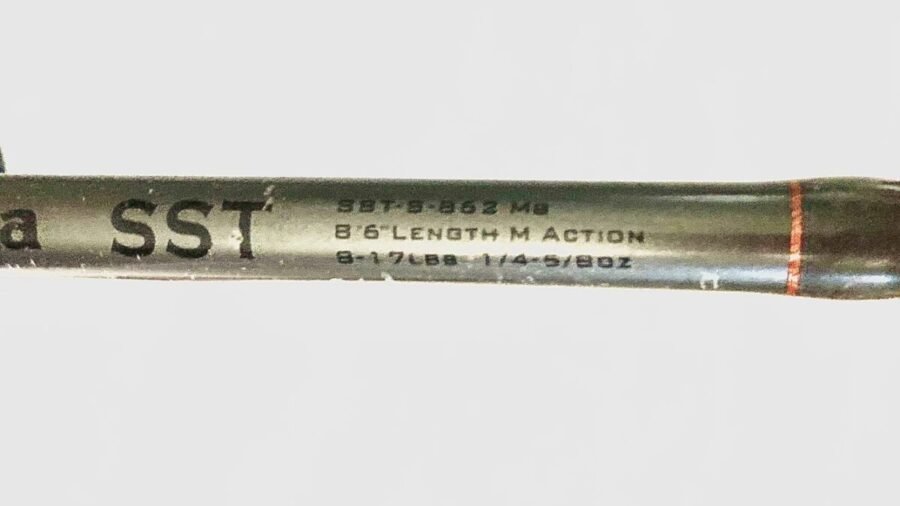
Model Number
This is the manufacturer’s abbreviated/descriptive name of the product.
Line Weight
Refers to the recommended line weight you should use with the rod (usually in mono).
Lure Weight
(Usually in ounces/oz) refers to the approximate weight of the lure or bait you should throw on while using the rod. Many times the rod can actually throw more weight than this rating, but this is what the manufacturer recommends.
Number of Guides
This is just the quantity of guides (or eyelets) the rod has. So, “7+1″ is read as ” 7 guides plus the tip” which actually means 8 total guides. There are certain benefits to having more or less of these but things can get complicated when comparing the two “lighter rods” to the shark rod. For lighter rods, expect a guide per every foot to be sufficient. Heavy rods can have fewer guides and still be great rods; as is the case with the Fiblink Moonsniper.
Number of Pieces
Number of pieces the rod breaks down into.
Rod Length
Length of the rod when all pieces are put together.
Power
(Usually, you’ll see anything from “Ultra Light” (UL), to “Heavy” (H) or (HA). Imagine this as the strength of the rod in terms of how much it can take in a fight or how much weight it can pull. While power refers to the rod working against the fish, “Taper” or “Action”, refers to casting… for the most part. I guess I should say it mostly works that way, although they both affect both aspects of fishing.
Taper
Taper (or Action) refers to where the rod bends. The most common tapers are M (moderate) and MF (moderate-fast), but as depicted in the illustration below, there are a number of different tapers that allow for more and less bend in your rod. The reason, I say this affects casting, is because faster taper results in the rod tip whipping back into position (inline with the rest of the rod) from wind-up to swinging; meaning the rod tip catches up with the rod body faster, allowing for stronger and likely further casts, depending on the weight of your lure or bait. See chart below.
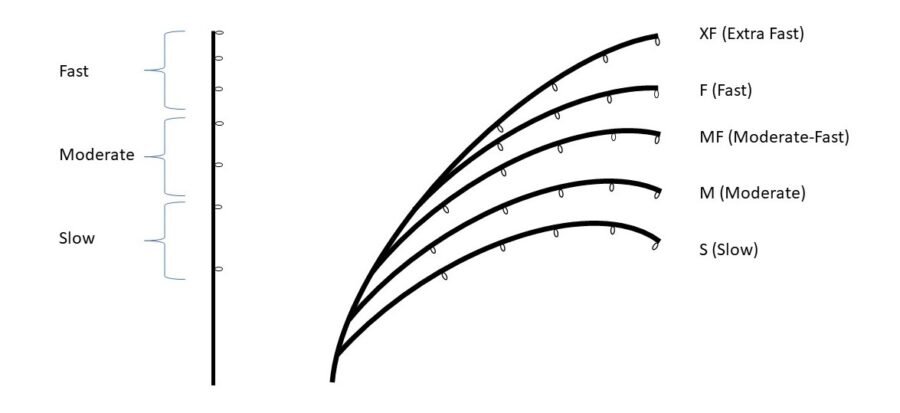
All of these specs factor in to what the best surf fishing rod will be for your specific needs. Do you need to cast further? Maybe your hook set needs to be quick and firm. or maybe your hook set needs to be cushioned by a little more bend in the rod. Maybe you need a little give mid-fight because your target species frequently changes directions or gives a lot of headshakes. All these things are extremely important. Let’s talk about each one by one.
Does A Longer Rod Help You Cast Further?
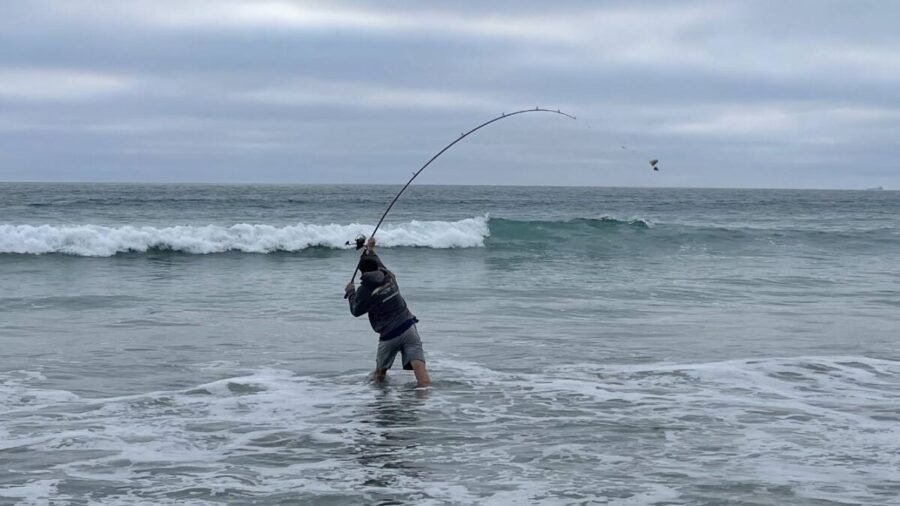
Yes, and no. A longer rod will generally allow you to cast further, but the specs have to make sense in order for it to really benefit you. For example, when I started surf fishing for white seabass, I wanted a rod that would allow me to cast further. I also wanted my surf fishing rod to be firm and strong enough to twitch and set the hook with little “give” while using swimbaits. It also had to be capable of throwing a little more than an ounce and I wanted to use 30 pound braid for my mainline because I was going to be targeting some relatively big fish. Sensitivity in feeling the bite was also important but with lures, it’s all typically pretty obvious.
So, I found the Okuma SST-S-902HA. Check out the specs below.
| Model # | Line Weight | Lure Weight | # of Guides | # of Pieces | Length | Power | Taper |
|---|---|---|---|---|---|---|---|
| SST-S-902HA | 10-30lbs | 1/2-2oz | 8+1 | 2-pcs | 9’0″ | H | MF |
What Makes A Fishing Rod Cast Further?
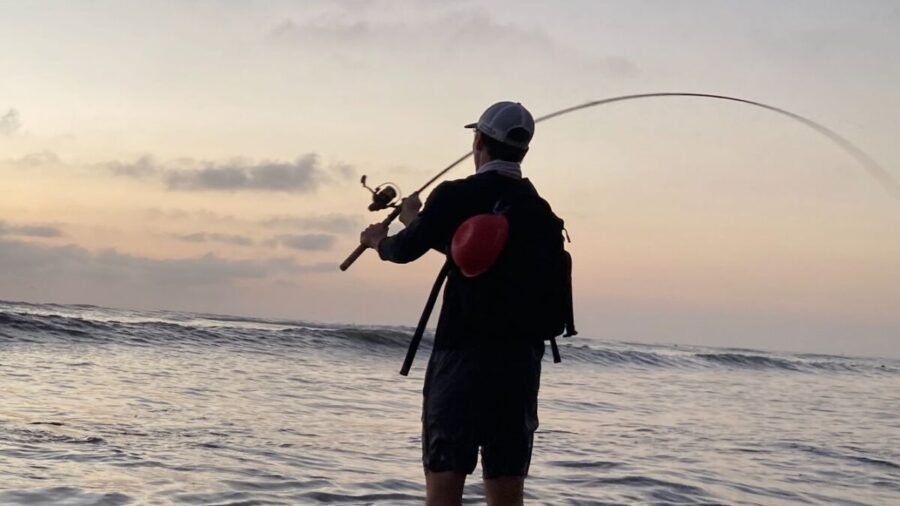
The combination of a longer rod (9′ vs 8’6″) with a moderate-fast action and a rating of 1/2 – 2oz is what allows this rod to cast further with the swimbaits that I typically throw. My typical swimbait’s combined total weight is 5/8 oz.
Additionally, given that I wanted my hook sets to be very “immediate” with little “give”, using braid was important because it doesn’t stretch much. That’s one of the many differences between braid vs mono.
What Makes A Fishing Rod Capable of Handling Bigger Fish?
Believe it or not, length had very little to do with how heavy or big a fish it can handle. The three specs that matter most when it comes to determining how big a fish a rod can handle are line weight, lure weight, and power. The heavier all of these are, the bigger the fish it can handle. It’s as simple as that.
But this doesn’t mean you should just go ahead and outclass your fish. You should match your gear to the class of your fish because there are other things like sensitivity etc. involved in choosing the best surf fishing rod.
What Makes A Fishing Rod “Sensitive” Enough To Detect Bites?
Sensitivity is probably the most under-rated factors to consider when selecting the best rod for surf fishing. Let’s switch to my light tackle Carolina rig set up. For those of you who don’t already know, the Carolina rig is the best rig for surf fishing with sand crabs. And yes, surf fishing with sand crabs is the method that will catch corbina, spotfin croaker, surfperch, and many other common surf species of fish.
So, when I’m surf fishing with sand crabs, one of the most important factors I look for in a rod is its sensitivity. Why? Because I’m not retrieving my bait. I’m casting and letting my bait freely drift or lay in an area while I try to maintain proper tension through the waves, the current, the seaweed, etc. This is where it’s incredibly important to be able to detect the difference between a bite and everything else; hence the importance of sensitivity in a fishing rod.
So, what specs play into how sensitive a fishing rid is? The answer? All of them! This is where you need to match up all the rod specs together and compare them to the class of your target species as well as the environment you’ll be fishing in. Depending on which factors matter most to you, maybe not all the specs will make sense or “correlate” accurately to your target, but that just goes to show why the rod is such a personalized piece of surf fishing gear and tackle.
Summarizing How To Choose The Best Surf Fishing Rod
If you’ve read all the sections above and you’ve read the linked article on the best rods for surf fishing, you should be able to piece together the right rod for you that’s specific to your target species based on my pairings per target species. And as always, if you have questions or need advice, let me know via the contact us page! Tight lines and I hope you find the best rod for surf fishing with the right specs, length etc. for your needs!
